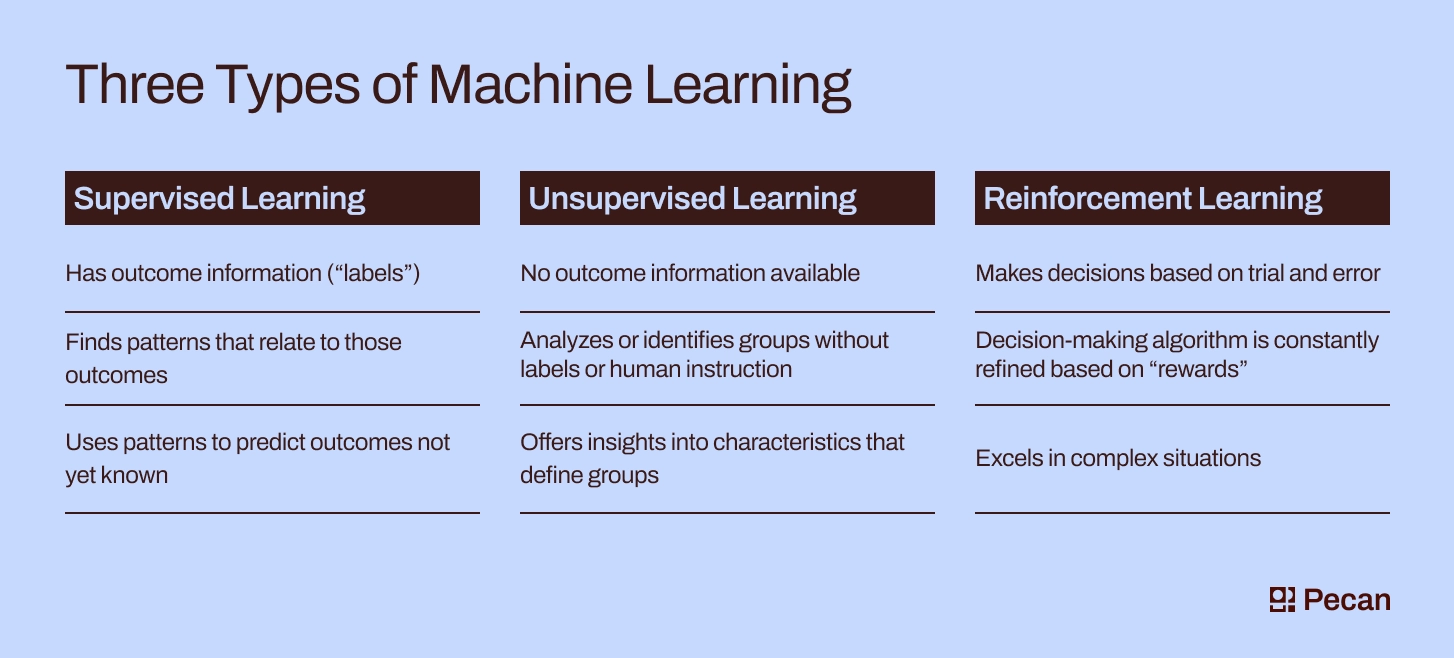In a nutshell:
- Machine learning can be divided into supervised, unsupervised, and reinforcement learning paradigms.
- Supervised learning predicts future outcomes based on past data with known labels.
- Unsupervised learning uncovers patterns in data without known labels to classify future outcomes.
- Reinforcement learning uses trial and error to improve decision-making over time.
- Each paradigm has unique approaches to learning and predicting outcomes.
Pull up a chair. We’ve got a little story for you.
Once upon a time, in a cozy little school tucked away in a charming village, there were three extraordinary teachers. These three educators each had a very special talent for teaching in their own unique style.
The first of the three gently guided her students step-by-step and showed them examples of what they should learn. With her help, the students could master all sorts of skills.
The second was a curious explorer. He didn’t need to give any instructions; he would observe his students and let them explore and discover on their own. Presented with a variety of materials, the students would sort them all out, finding hidden patterns and insights all by themselves.
Finally, the third teacher was a daring adventurer. They believed that the best way for students to learn was through hands-on experience and trial and error. Their students became problem-solving masters, taking on challenges one step at a time and learning from their successes and mistakes.
It sounds like a fairy tale, but let’s make it even more fantastical: Each of these teachers represents a method for teaching machines to learn from information and then generate new insights based on their learning. These are the three types of machine learning.
Let’s dig in a little further into what these types are and what they mean in Pecan.
The three types of machine learning and Pecan
Generally, based on the way algorithms learn from data, machine learning can be divided into three paradigms, as you read above: supervised learning, unsupervised learning, and reinforcement learning.
The primary difference between them lies in the results they produce, and the way they validate and calibrate those results.
Using Pecan, you can create different types of models that fall within the domain of supervised learning. The type of model that best fits your data – whether binary, multiclass, or regression – will automatically be detected by Pecan’s platform once data is fed into it.

Three key types of machine learning
Supervised learning
In supervised learning, a model learns to predict the future based on what happened in the past.
Here, historical data with “ground-truth labels” (where there is an actual observed outcome for each input) is fed into supervised learning algorithms. So you might classify users who performed a certain behavior with a 1, and others with a 0.
The algorithm will identify correlations, patterns, and trends that are historically correlated with these ground-truth outcomes and then use them to predict the future.
Generally, you want your predictions to match ground-truth outcomes as frequently as possible – that is, you want your model to make as many correct predictions as it can. (Although it’s worth noting that accuracy is not the only worthy measure of a machine learning model.)
Unsupervised learning
In unsupervised learning, a model attempts to understand what happened in the past so it can be used to classify future outcomes.
Unsupervised learning makes it possible to uncover patterns in datasets where ground-truth labels are not available – that is, when records cannot be labeled with a certain target behavior (i.e., classified with a 0 or 1). The objective is to understand past outcomes, how they can be grouped or labeled, and what hidden patterns they hold. With that information in hand, future behavior can be labeled and predicted.
Here, you would run an unsupervised model where the algorithm doesn’t have a target (e.g., 1 or 0) but rather looks at the behavior of different customers or other entities and tells you which ones are behaving similarly to each other. It’s “unsupervised” because the model builder never tells the AI which classifications to perform.
However, you can manually assess the results and identify certain qualities that exist among groups. So while you may not be able to identify, say, people who are likely to commit fraudulent activity, you may identify classifications related to income level, shopping habits, etc.
Reinforcement learning
In reinforcement learning, a model uses trial and error to iteratively improve its approach to making decisions. The algorithm continually tries new things to learn how to behave better in the future.
Here, raw data (whether in real-time or in batches) serves as the input. The reinforcement learning algorithm learns by constantly seeking new approaches to a problem and improving upon approaches that maximize the defined “reward.” This type of learning is frequently used in robotics and gaming.
Which type of machine learning should you use?
In addition to considering the kind of problem you’re trying to solve, as discussed above, there are also some additional factors that affect which approach you should select:
- Amount and quality of data: Supervised learning requires a large amount of labeled data, while unsupervised learning can work with unlabeled data. Reinforcement learning may need a simulation environment.
- Available resources: Supervised learning algorithms are generally faster and easier to implement, while reinforcement learning can be more complex and computationally expensive.
- Interpretability: If you need to understand the decision-making process of the model, supervised and unsupervised learning methods are generally more interpretable than reinforcement learning models.
Ultimately, the choice depends on your specific problem, the type of data you have, and the resources and constraints you’re working with. It’s also common to use a combination of different machine learning techniques in more complex problems.
Get started with your supervised machine learning project
Does it sound like your project fits a supervised learning approach? If so, you’re in the right place, because Pecan can help you get started!
Using a low-code platform like Pecan can be a great way to streamline the process and make it more accessible, even for those without data science or coding experience. Here’s a brief overview of how you could approach it:
- Understand your problem: Start by clearly defining the problem you’re trying to solve. Pecan’s Predictive Chat will help you walk through this process, guiding you toward a well-defined predictive question that will be the basis for your machine-learning model. For supervised learning, you’ll need to have labeled data that you can use to train a model to make predictions or classifications.
- Gather your data: You may have heard that you’ll need to clean, transform, and split your data prior to building a machine-learning model. But the good news: You’ll just need to connect to your data through Pecan using our no-code connector options or a CSV file. Pecan supports a variety of data types and will handle data prep and feature engineering for you.
- Automate model building: Pecan will automatically build a variety of models for you, and then select the one that performs best. No need to manually build and test multiple machine learning models by coding them from scratch: Pecan takes care of this behind the scenes.
- Evaluate and iterate: Review Pecan’s intuitive, easy-to-use dashboard to see how your model is doing, then decide whether you’re ready to move forward to put the model in production or want to iterate further. Pecan provides visualizations and explanations to help you understand and interpret the models.
- Deploy and monitor: Once you’ve selected your model, you can deploy it using Pecan’s deployment tools. These tools enable you to integrate your model into your existing business systems with just a click.
By leveraging Pecan’s low-code automated predictive analytics platform, you can streamline the process of building and deploying supervised machine learning models, even if you have limited coding experience. Pecan’s user-friendly interface and automated capabilities can help you quickly explore and iterate on different models, while still providing transparency and interoperability.
Read through these three types of machine learning, and ready to build your supervised machine learning model now? Get a personal tour.





